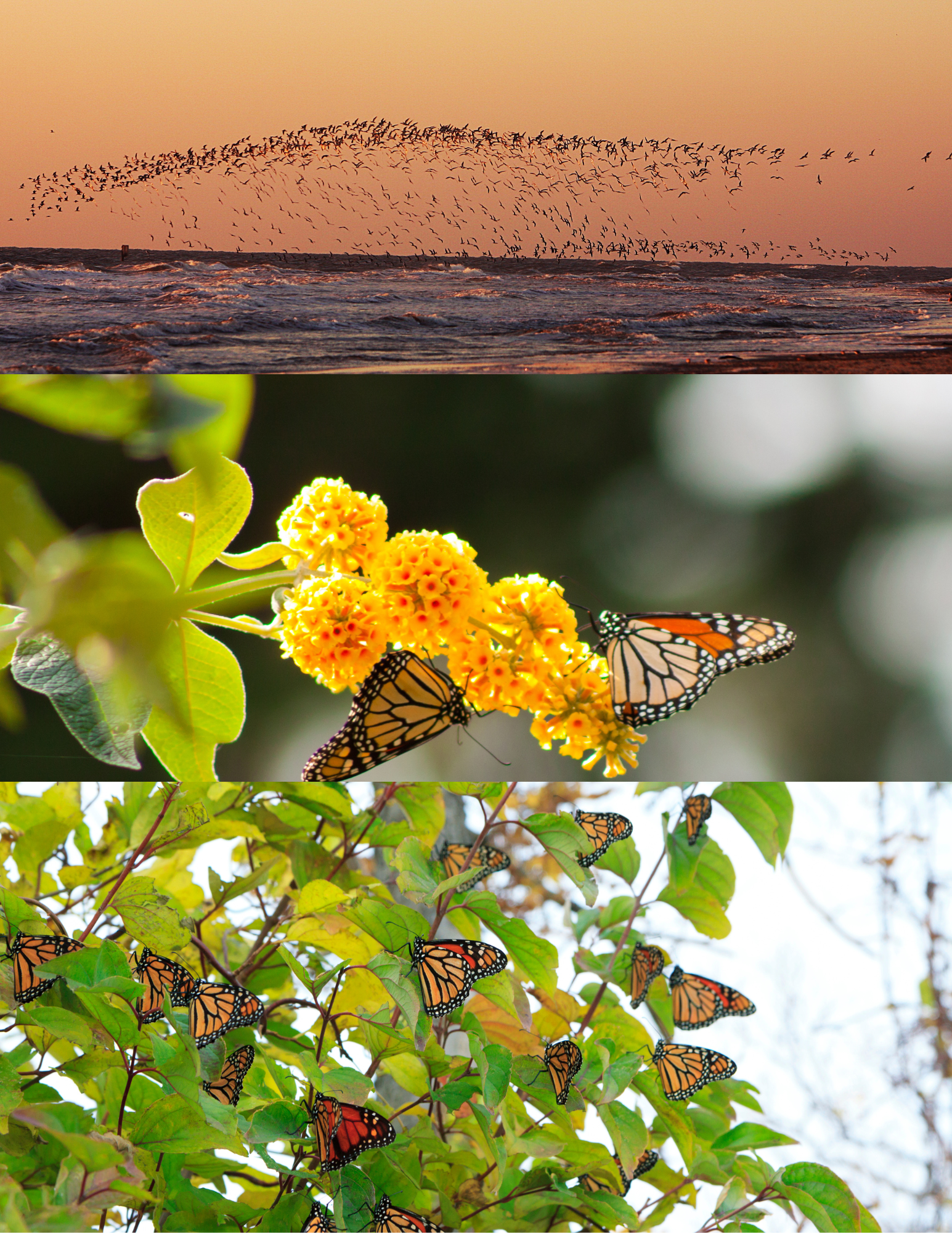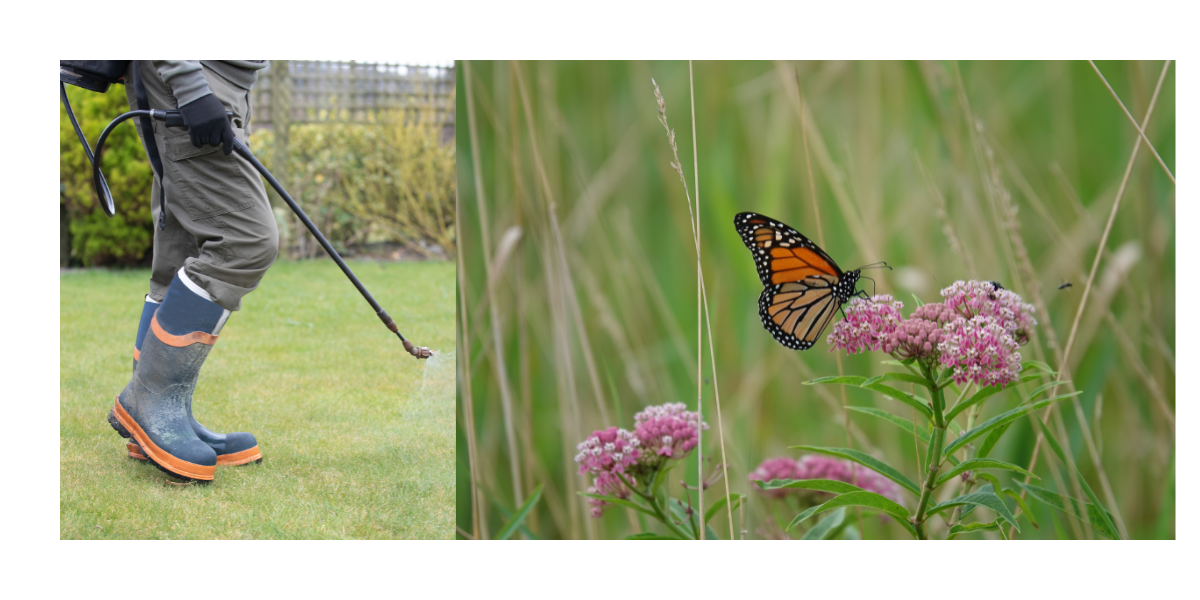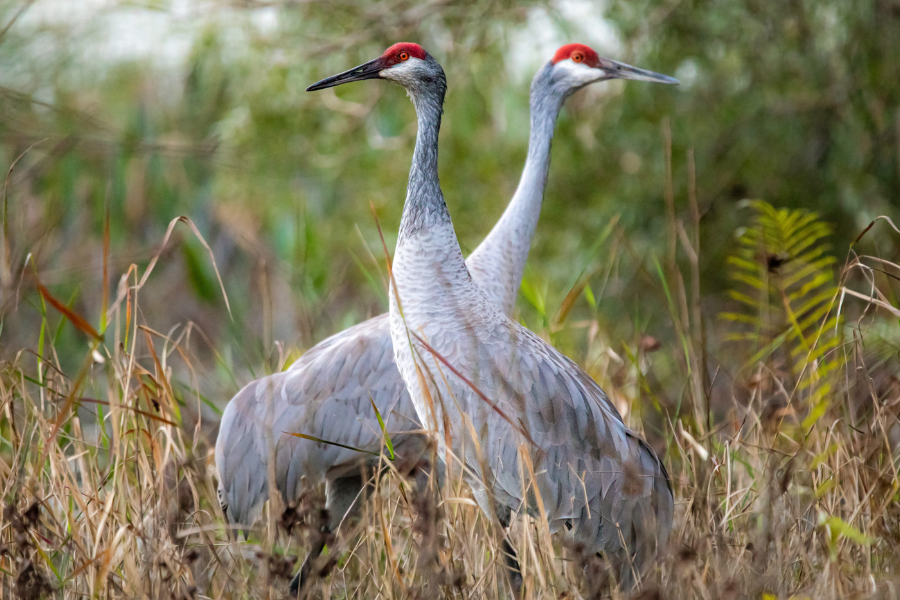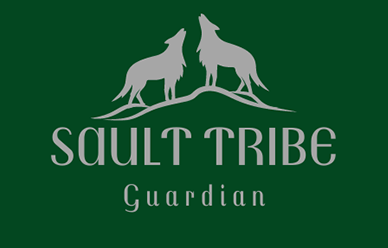October 13 2024. Collaborative Conservation for Species on the Move.
A Shared Journey.
As cool breezes of fall sweep across parts of North America, our skies fill with a remarkable spectacle—monarch butterflies and migratory birds embark on their long journeys southward. Both monarchs and migratory birds are driven by the changing seasons, seeking warmer climates where they can rest, refuel, and continue their life cycles. This natural phenomenon is not just awe-inspiring to witness; it’s critical for their survival.
Monarch butterflies, with their fragile wings, migrate from as far north as Canada to the mountainous forests of Mexico. Similarly, neotropical birds fly north to breed in Canada and the United States before traveling back to their non-breeding grounds across Latin America and the Caribbean. While vastly different in size and shape, these species share a similar need: habitat along their migration routes.
The 2024 World Migratory Bird Day theme focuses on the relationship between birds and insects with the theme, “Protect Insects, Protect Birds.” Both birds and insects (like monarchs!) depend on the conservation of native plants and healthy, bio-diverse habitats—such as wetlands, forests, and grasslands—for the resources they need to survive. The U.S. Fish and Wildlife Service work with partners to protect, restore, and conserve these species and their habitats for the benefit of future generations.

Connecting Flights.
Every fall, millions of monarch butterflies set off on a journey that can span up to 3,000 miles, traveling from as far north as Canada to the highland forests of central Mexico. Around the same time, thousands of bird species—like the tiny ruby-throated hummingbird—make similarly arduous journeys, crossing oceans and continents to reach their destination.
Monarch butterflies follow a multi-generational migration pattern. The butterflies that reach Mexico are not the same individuals that left the northern breeding grounds in the spring. Instead, each generation of monarchs plays a part, with the final generation in late summer making the entire trip south.
In contrast, migratory birds often return year after year to the same sites, guided by an internal compass and the changing positions of the sun, moon, and stars. Though their methods differ, both monarch butterflies and migratory birds share the remarkable resilience and adaptability needed to survive. To make it to their destinations, they must find food, water, and resting places along the way, underscoring the need for healthy stopover habitats.
Threats to Survival.
Monarchs and migratory birds may follow different paths, but they face many of the same challenges. Habitat loss is the greatest challenge, as urban development, the conversion of grasslands for agriculture, and deforestation reduce the availability of key habitats both species need to breed, feed, and rest throughout their life-cycles.
Monarchs require milkweed plants (Asclepias spp.) to survive. The female monarch butterflies will lay their eggs on milkweed leaves and the monarch caterpillars can only eat milkweed plants. Adult monarch butterflies can then feed from the milkweed nectar and a wider range of flowers. Milkweed is also a great plant to attract birds, including warblers, wrens, thrushes, orioles and vireos. American goldfinches use the fiber from milkweed to build nests for their chicks and can eat the downy part of the seed. Chickadees gather the seed fluff in late summer and store it for insulation. American tree sparrows and juncos eat milkweed seeds in the fall and winter when food resources are more scarce. It also attracts insects that aerial insectivores like American kestrel and purple martin may eat throughout the summer.
The use of herbicides and pesticides is another shared threat. Continued exposure to these chemicals can harm monarch caterpillars feeding on contaminated milkweed and adult monarchs feeding on contaminated flowers. Pesticides also reduce insect populations that migratory birds rely on for food. In particular, neonicotinoids, a class of systemic pesticides commonly used in agriculture, have been shown to negatively affect these beneficial species and the soil microbes that support healthy ecosystems.
Climate change presents another growing challenge. Warmer temperatures and shifting weather patterns can disrupt migration timing and food availability. For example, monarchs rely on blooming nectar plants, and if they arrive too early or too late, they may find that food sources are scarce. Similarly, migratory birds need to time their migration for when insects and flowering plants are abundant, which affects their ability to continue their journey, breed, and feed the next generation. These shared challenges make it clear that protecting monarchs and migratory birds requires coordinated, large-scale conservation efforts. Fortunately, a growing number of studies show that habitat conservation for birds can also benefit monarchs!

Continental Conservation.
By conserving and restoring grasslands, wetlands, forests, and coastal habitats, we not only support monarchs and birds but also preserve the broader ecosystems that sustain them. These species rely on a variety of landscapes, plants, and other animals to find food, shelter, and rest throughout their life-cycles.
For example, the Central Flyway, a bird migration route stretching from the Great Plains to the Gulf of Mexico, famously hosts millions of birds like the sandhill crane, which depend on wetlands like Nebraska’s Platte River Valley for important stopover habitat. Monarch butterflies use this same area to refuel on nectar-producing plants during their long journey. Also in the Central Flyway, places like the Green Bay National Wildlife Refuge in the Great Lakes area offer shelter and food for both monarchs and migratory songbirds, such as the golden-winged warbler. Songbirds and monarchs share a dependence on landscapes filled with native plants, which provide food in the form of insects, seeds, and berries for birds, and nectar for butterflies.
Grant programs like the North American Wetlands Conservation Act (NAWCA) and the Neotropical Migratory Bird Conservation Act (NMBCA) play a vital role in protecting these shared habitats across the hemisphere. For example, the NAWCA program provides critical resources to protect, restore, and enhance wetlands and associated upland habitats in Canada, the United States, and Mexico, benefiting both birds and pollinating insects like the monarch butterfly. Meanwhile, the NMBCA supports conservation projects for neotropical birds, which often includes work in Mexico that can also benefit migrating monarchs. By protecting and managing the habitats monarchs and birds share throughout their lifecycles, we help preserve the delicate ecosystems that support them during their epic journeys, increasing their chances of returning year after year.
Power in Partnerships.
In our Migratory Bird Program, strategic partnerships—like those formed through Migratory Bird Joint Ventures and international grant programs like the NMBCA and NAWCA—are crucial to our mission of working with partners to protect, restore, and conserve bird populations and their habitats. Likewise, the FWS Center for Pollinator Conservation connects land managers, policymakers, scientists, and program leaders in coordinated efforts to address declining pollinator populations.
For monarchs, collaborative initiatives like the Monarch Joint Venture unite federal and state agencies, NGOs, and academic partners to protect monarch habitats across their migratory range. By working together across borders, partnerships like these connect local efforts with large-scale approaches to habitat conservation that benefit both migratory birds and monarch butterflies, ensuring that future generations can witness the incredible migrations that connect us all.
What You Can Do: Protecting Monarchs and Birds at Home.
You don’t need to travel far to help migratory birds and monarch butterflies—you can make a difference right at home. Here are a few simple actions that can support both species:
- Plant Native Species: Native plants provide essential resources for both monarchs and birds. Monarch caterpillars feed exclusively on milkweed, so planting it in your garden helps sustain their populations. Birds benefit from a wide range of native flowers, grasses and trees, especially native oak trees that also provide roost habitat for both monarchs.
- Provide Water and Shelter: A shallow water source can provide much-needed hydration for both birds and monarchs, particularly during the heat of migration. Leaf litter and dead trees in your yard can offer shelter and nesting materials for a variety of species.
- Reduce Pesticide Use: Limit or eliminate harmful chemicals in your area to protect monarch caterpillars and the insects that birds rely on for food. Consider Integrated Pest Management or planting pest-resistant native plants to support pollinators and other beneficial species.
- Support Local Conservation Efforts: Get involved with local conservation initiatives that work to restore habitats. Programs like citizen science bird counts or monarch tagging projects help scientists track populations and migration patterns, providing crucial data for conservation efforts.
- Turn Underutilized Spaces into Conservation Areas: Encourage businesses and organizations in your community—whether in rural, suburban, or urban areas—to transform spaces into micro habitats. Even small changes can have a big impact for species like insects and birds! For example, the "Monarchs in the Rough" initiative, a partnership between Audubon International and the Environmental Defense Fund, works with golf courses to plant milkweed and other pollinator-friendly plants in underutilized spaces.
- Minimize Light Pollution: Lights at night are a threat to all species, including humans. Migrating birds rely on a dark night sky to navigate their ancient flyways. Both birds and insects can become disoriented by artificial light at night, which can interfere with their rest and make them more at risk of collisions or predators. Monarchs exposed to nighttime light pollution, like a street lamp above their roost tree, can experience a phase shift, making their body think it's either earlier or later than it really is. This can throw off their sense of time. By reducing our use of lights at home and in our communities, we help preserve dark skies, protect wildlife at night and reduce risks to human health all at the same time!
Small changes like these can make a big impact for birds and insects!
Making Way for Migratory Marvels.
As monarch butterflies and migratory birds continue to face increasing threats, coordinated conservation efforts are more important than ever. Everyone can play a role in protecting these incredible creatures. By taking steps to restore and protect habitats, reduce harmful pesticide use, and participate in local conservation projects, we can help ensure that future generations will witness the awe-inspiring migrations of monarch butterflies and migratory birds across North America.



